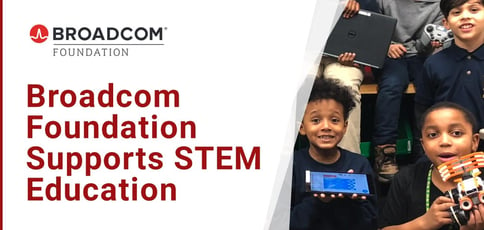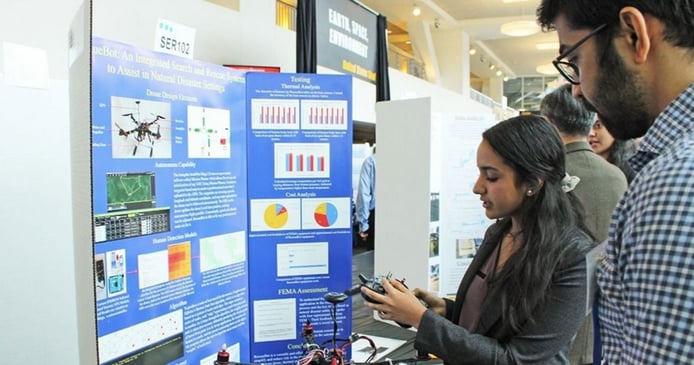
TL; DR: The Broadcom Foundation champions youth development by providing middle schoolers with the resources and opportunities to build careers in STEM. The nonprofit corporation’s focus on coding targets underserved youth and creates equitable access for students to foster their passion for solving problems with programming. The foundation seeks to teach students to become not only successful career professionals but also good citizens who better the world. Broadcom’s advocacy doesn’t stop at the regional level. The foundation also tackles national policy to attract more funding to help create a brighter future for the STEM ecosystem.
STEM careers have helped shape the world as we know it. STEM professionals have created life-changing breakthroughs in research and worked tirelessly to advance the fields of physics, computer science, and engineering, among many others.
And STEM career opportunities are forecasted to grow faster than non-STEM careers. By 2029, occupations in STEM will increase 8% compared with 3.7% for all other disciplines.
The U.S. private sector has long relied on a foreign workforce to drive innovation in the scientific and mathematical departments. But that overseas talent pool has dried up over the years, and the need for domestic workforce development and accessibility is more urgent than ever.
Ten years ago, the Broadcom Corporation’s board created the Broadcom Foundation to respond to this problem and open avenues for young students to develop careers in STEM.

“Broadcom wanted to make a difference in STEM education. Establishing the foundation was basically to create opportunities and close the gap for women and underserved. The company was hopeful that its efforts in STEM Education would inspire students to become engineers at companies like ours, believing there is a need for more engineers on the planet,” said Paula Golden, Broadcom Foundation President.
Broadcom Foundation partners with organizations that focus on after-school STEM learning to help middle school students foster their budding passion for all things STEM. The foundation spotlights that pursuing a career in STEM not only provides job security but drives the integral pieces of the U.S. economy for everyone.
“We believe middle school is the space where kids will make a turn in the road as independent thinkers. They’re waking up to their individuality and passions. And if we can inspire them to see that whatever they have as a passion is a pathway to a STEM career, it’ll drive the choices they make going forward into high school,” said Paula.
Creating Pathways for Students to Enter STEM Careers
The Broadcom Foundation started as the brainchild of Henry Samueli, who found his passion for STEM in middle school. While he did not have engineering mentorship or a role model, he was able to create a two band radio receiver from a Graymark 506 B kit for seventh-grade shop class. His teacher recognized his talent and set him on the path to a career as an electrical engineer.
The Broadcom Foundation empowers children in their journey to career development, presenting them with opportunities well beyond the radio kit that inspired Henry. Its mission is especially significant for youth in underserved communities that rely on fewer resources. The foundation works with science fairs and after-school programs to help youth access STEM opportunities to develop their learning path.
Paula said the foundation wants science fair judges to reward middle school students whose passion for STEM drives what they want to do regardless of their resources. “So Science Fairs are great place to reach underserved kids who can see what other students their age can do,” said Paula.

The Broadcom Foundation’s programs provide equitable access to STEM education so students can acquire transferable soft skills in critical thinking, collaboration, communication, and creativity. These skills will prepare them for the fundamentals of the job and leadership and innovation for the future.
Paula told us the Broadcom Foundation operates on a separate quasi-endowed budget and spends around $5 million a year to achieve its goal to create pathways for students.
“We realized that we wanted to leverage our money, not in small gifts as a general rule, but in a programs that enable us to be thought leaders in STEM education,” and Paula.
The Broadcom Foundation partners with several organizations, including The Society for Science and the Public and Raspberry Pi Foundation, to raise awareness through initiatives that tackle youth development and the equity gap. These partnerships help the foundation reach more students and provide them with the best opportunity.
Switching Gears with a Narrowed Focus on Coding
Although the Broadcom Foundation began with a broader portfolio for STEM, Paula told us the team has decided to narrow its portfolio to coding. That way, the foundation can better serve students and allocate resources into one targeted STEM goal.
“We’ve decided to narrow our focus to coding because over the years, we’ve watched how kids use more coding and computation in science projects. And because of our connection to Raspberry Pi Foundation, we’re partnering on a new project called Broadcom Coding with Commitment,” said Paula.
Broadcom Coding with Commitment is a coding and citizenship program that applies to the United Nations 17 Sustainable Development Goals. The UN backdrop allows youth to build projects that showcase their dedication to changing the world and use coding to solve problems. The Broadcom Foundation seeks to help students become successful career professionals and good citizens who care about the world.
The Broadcom Foundation’s role to encourage students and serve as a guide has been paramount for students in their coding journey. By supplying them with opportunities rooted in STEM subjects, Broadcom helps students feel inspired and more confident in their skills so they stick with STEM and coding until they reach college.
The Broadcom Foundation promotes project-based learning and collaboration to help students experience the skills they need as STEM professionals. Paula said the foundation is exploring relationships with various organizations, including The Million Girls Moonshot, Boys and Girls Club, and Girls, Inc, to make coding more accessible through after-school code clubs.
Tackling National Policy for a Brighter STEM Ecosystem
Broadcom Coding with Cmmitment doesn’t have a sole purpose. Paula told us the Broadcom Foundation designed the program to create a national policy platform for education and said the classroom is a critical component.
“The major challenge is that the United States has no uniform national policy for education. It needs a strategy to engage the private sector in that process because the private sector is deprived of a domestic workforce,” said Paula.
The Broadcom Foundation shines a light on how young people are the future of the workforce, and the government should make policies to support their growth. The foundation participated in a five-year strategic plan for STEM of the Office of Science and Technology Policy by offering ideas to encourage broadband funding in the infrastructure bill to bolster access to STEM education.
To increase regional STEM strategies and strengthen the future workforce, Sen. Mark Kelly from Arizona and Sen. Jerry Moran from Kansas recently proposed a bipartisan federal bill that would provide $25 million for STEM ecosystems. By establishing a grant program within the National Science Foundation, regional and local organizations would receive the federal support they need to fund STEM education in public schools and after-school programs.
Paula said the federal funding in this bill would also give STEM organizations the capacity to seek greater support from the private sector and the business community.
“I believe we are on the verge of creating a drumbeat into the business community to step up on the workforce development front. There’s a growing recognition at a very high level that without the support of the federal government and companies such as ours, we can’t get to where we need to be,” said Paula.


